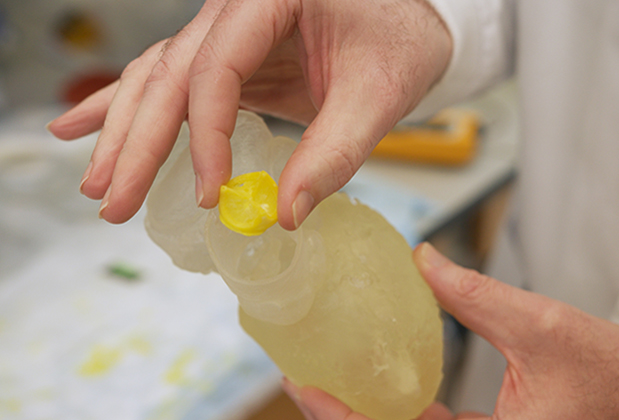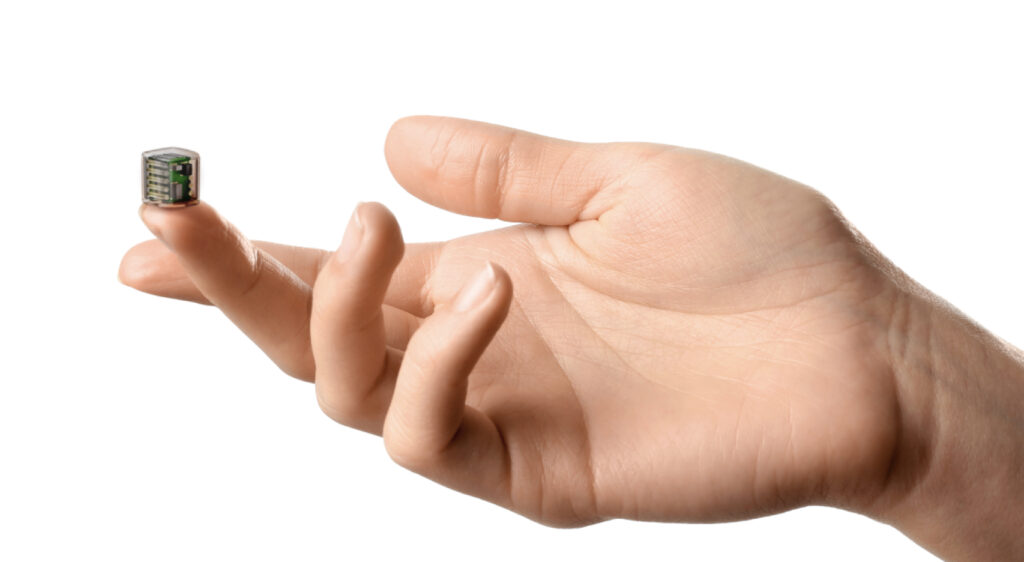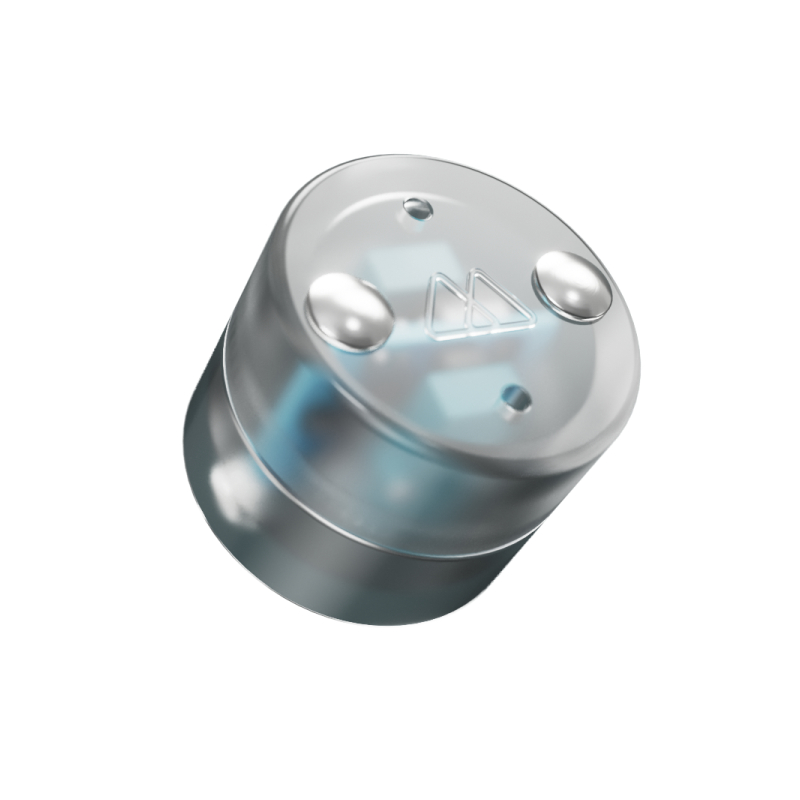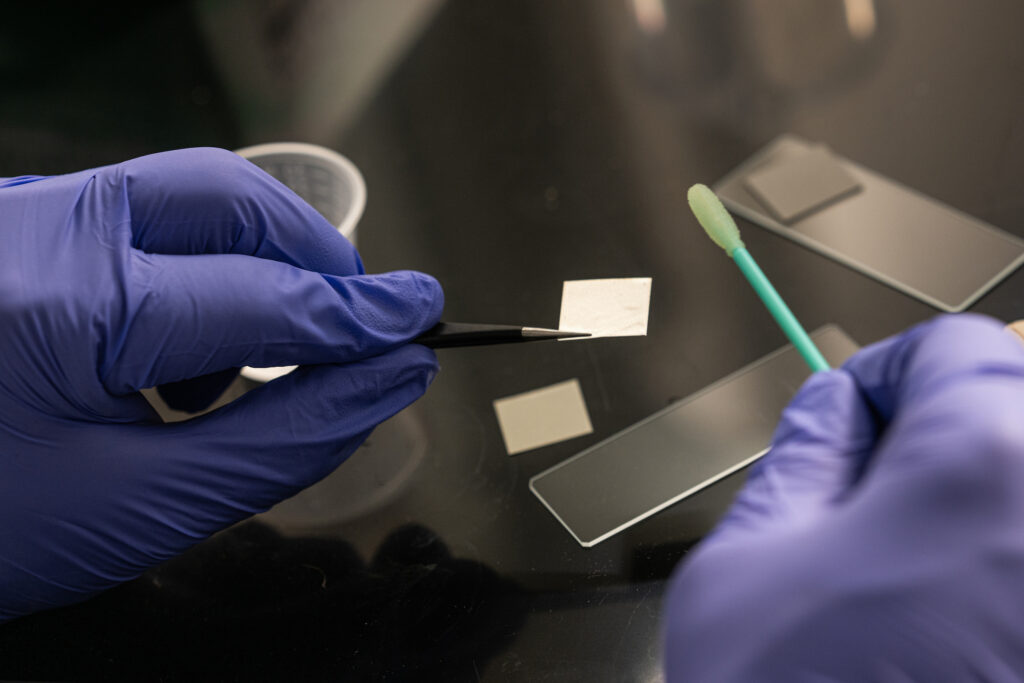
The bioresorbable heart valve (yellow), which promotes tissue regeneration, is pictured with a 3D-printed heart model. (Photo courtesy Christopher McKenney)
New Implant May Help Patients Regenerate Their Own Heart Valves
A 3D-printed, bioresorbable heart valve promotes tissue regeneration, potentially eliminating the need for repeated surgeries for adult and pediatric heart patients.
By Catherine Barzler
ATLANTA—Every year, more than 5 million people in the U.S. are diagnosed with heart valve disease, but this condition has no effective long-term treatment. When a person’s heart valve is severely damaged by a birth defect, lifestyle, or aging, blood flow is disrupted. If left untreated, there can be fatal complications.
Valve replacement and repair are the only methods of managing severe valvular heart disease, but both often require repeated surgeries that are expensive, disruptive, and life-threatening. Most replacement valves are made of animal tissue and last up to 10 or 15 years before they must be replaced. For pediatric patients, solutions are extremely limited and can require multiple reinterventions.
Now, Georgia Tech researchers have created a 3D-printed heart valve made of bioresorbable materials and designed to fit an individual patient’s unique anatomy. Once implanted, the valves will be absorbed by the body and replaced by new tissue that will perform the function that the device once served.
The invention comes out of the labs of faculty members Lakshmi Prasad Dasi and Scott Hollister in the Wallace H. Coulter Department of Biomedical Engineering (BME) at Georgia Tech and Emory.
“This technology is very different from most existing heart valves, and we believe it represents a paradigm shift,” said Dasi, the Rozelle Vanda Wesley Professor in BME. “We are moving away from using animal tissue devices that don’t last and aren’t sustainable, and into a new era where a heart valve can regenerate inside the patient.”
Dasi is a leading researcher in heart valve function and mechanics, while Hollister is a top expert in tissue engineering and 3D printing for pediatric medical devices. They brought their teams together to create a first-of-its-kind technology.
“In pediatrics, one of the biggest challenges is that kids grow, and their heart valves change size over time,” said Hollister, who is professor and Patsy and Alan Dorris Chair in Pediatric Technology and associate chair for Translational Research. “Because of this, children must undergo multiple surgeries to repair their valves as they grow. With this new technology, the patient can potentially grow new valve tissue and not have to worry about multiple valve replacements in the future.”
Growing Into the Heart
Although 3D-printed heart valves currently exist and bioresorbable materials have been used for implants before, this is the first time the two technologies have been combined to create one device with a resorbable, shape memory material.
“From the start, the vision for the project was to move away from the one-size-fits-most approach that has been the status quo for heart valve design and manufacturing, and toward a patient-specific implant that can outlast current devices,” explained Sanchita Bhat, a research scientist in Dasi’s lab who first became involved in the project as a Ph.D. student.
The initial research involved finding the right material and testing different prototypes. The team’s heart valve is 3D-printed using a biocompatible material called poly(glycerol dodecanedioate).
The valve has shape memory, so it can be folded and delivered via a catheter, rather than open heart surgery. Once it is implanted and reaches body temperature, the device will refold into its original shape. The material will then signal to the body to make its own new tissue to replace the device. The original device will absorb completely in a few months.
Srujana Joshi, a fourth-year Ph.D. student in Dasi’s lab, has played a major role in testing and analyzing the heart valve’s design and performance.
“Once you have an idea for an implant, it takes a lot of fine-tuning and optimization to arrive at the right design, material, and manufacturing parameters that work,” Joshi said. “It is an iterative process, and we’ve been testing these aspects in our systems to make sure the valves are doing what they’re supposed to do.”
Bhat and Joshi are currently testing the heart valve’s physical durability with both computational models and benchtop studies. Dasi’s lab has a heart simulation setup that matches a real heart’s physiological conditions and can mimic the pressure and flow conditions of an individual patient’s heart. An additional machine tests the valve’s mechanical durability by putting it through millions of heart cycles in a short time.
A Paradigm-Shifting Technology
According to the researchers, it is an enormous challenge to create a material that can carry out a heart valve’s rigorous function, while also encouraging new tissue to develop and take over. Also, new medical devices undergo a long journey from bench to bedside, and several key milestones must be met.
The researchers hope their technology can revolutionize treatment for heart valve patients — and that it will usher in a new era of more tissue-engineered devices.
According to Dasi and Hollister, implants aren’t developed for pediatric populations as often as they are for adults. This is due to child diseases being rarer, along with the high cost of manufacturing. The researchers think that combining bioresorbable materials with 3D printing and manufacturing could be the key to developing better pediatric devices.
“The hope is that we will start with the pediatric patients who can benefit from this technology when there is no other treatment available to them,” Dasi said. “Then we hope to show, over time, that there’s no reason why all valves shouldn’t be made this way.”
Note: Harsha Ramaraju (research scientist), Ryan Akman (research scientist), Adam Verga (Ph.D. candidate), David Rozen (undergraduate student), Satheesh Kumar Harikrishnan (former research engineer), and Hieu Bui (former postdoctoral fellow) also played a major role in developing this technology.
Funding: Development of the bioresorbable material was supported by the National Institutes of Health grant number NIH/NHLBI R21-126004. This research received early financial support from the Georgia Research Alliance.
Catherine Barzler is a writer for Georgia Institute of Technology.
This article originally appeared in Georgia Tech Research News.
Source: https://research.gatech.edu/feature/heart-valves
Latest Version of Syringe Closure System Reported to Provide Easier Handling, Robust Locking Mechanism
Vetter’s proprietary system, still in development, will also feature improved gripping and a more intuitive opening mechanism, the company said.
RAVENSBURG, Germany—In January, the contract development and manufacturing organization (CDMO) Vetter announced its development and upcoming launch of the latest version of its proprietary V-OVS® syringe closure system.
The new closure, V-OVS® Next (stylized as V-OVS next), is expected to “further advance a proprietary system with many years of proven market success supporting and differentiating a range of sterile injectables,” the company said in a release.

Vetter’s new V-OVS® Next syringe closure system is reported to integrate “valuable real-world insights and customer feedback to set a new standard of functionality in the syringe-based product market.” (Image: © Vetter Pharma International GmbH)
“This latest evolution will integrate several unique technical advances guided by both shifting market needs and feedback from the many customers who have selected V-OVS® for their products,” the release stated.
Similar to the original system, the design of V-OVS Next will be optimized to protect the integrity of the injectable product secured by the closure. For customers with products in glass-barrel syringes, the new closure offers “an opportunity to integrate gold-standard Luer Lock features with even easier handling characteristics and an even more intuitive opening mechanism,” according to Vetter.
“With its proprietary tamper-evident features, we’re confident that V-OVS® next will bring a new level of user-friendliness to Luer Lock applications,” said Tobias Nemeth, director, primary packaging service and projects at Vetter, in the release. “It will further build on the decades of market impact delivered by this industry-leading system, and provide a differentiating choice for customers with an even wider range of injectable products.”
In addition to handling enhancements, the system’s overall size will be reduced to better fit smaller syringe sizes. The company has updated the gripping surfaces to provide optimal control during opening, and a robust new locking mechanism is expected to help keep the closure safely in place, even during the most challenging clinical use cases.
Although the syringe closure system is still in development, Vetter has already placed V-OVS Next on a launch pathway for 2027. For now, the focus remains on finalizing the system’s design and further advancing its commercialization, the company said in the release.
As part of its go-to-market preparations, Vetter recently conducted a successful human factors study with a representative group of frontline clinical users.
“The study delivered consistent positive feedback and insights that will directly contribute to finalizing the design of the new closure system,” the company said.
Vetter works with its customers to develop prefilled drug-delivery systems to continuously improve patient safety, comfort, and compliance. Headquartered in Ravensburg, Germany, Vetter has production facilities in Germany, Austria, and the United States. The contract development and manufacturing organization provides support from drug product development through clinical and commercial filling to a wide range of assembly and packaging services for vials, syringes, and cartridges.
Neurotechnology Startup Wins Award to Build Therapeutic Brain-Computer Interface
The multimillion-dollar award will support Motif Neurotech’s development of minimally invasive bioelectronics technology to treat cognitive and psychiatric conditions.
HOUSTON—Motif Neurotech is a privately held neurotechnology company that is working to develop miniature neural devices to help people regulate their mood, attention, and cognition. Its stated mission is to “help everyone live a better life with neural devices.”

A to-scale rendering of the prototype Motif DOT microstimulator used in the company’s first-in-human and large animal studies. (Photo: Business Wire)
The Houston-based company received a substantial boost in support of that mission recently. Motif Neurotech was selected by the U.K.’s Advanced Research and Invention Agency (ARIA) for a multimillion-dollar award that will support Motif’s development of a therapeutic brain-computer interface (BCI) technology to treat cognitive and psychiatric conditions, according to a release from Motif Neurotech.
The award will fund the development of a network of neural devices designed to monitor and regulate mental and cognitive states without brain surgery. It is part of ARIA’s Precision Neurotechnologies program, led by program director Jacques Carolan.

A 2024 rendering of Motif Neurotech’s Digitally Programmable Over-brain Therapeutic (DOT). (Photo: Business Wire)
By helping to regulate brain states associated with mood, attention, and sleep, the technology could have a profound impact on the treatment of cognitive, neurological, and psychiatric conditions.
“We are thrilled to be a part of this important program,” said Jacob Robinson, CEO of Motif Neurotech, in a statement. “This funding will allow us to accelerate our efforts to develop a general-purpose platform capable of accurately monitoring and regulating mental and cognitive states. The brain is an electrical organ. We believe that mental and cognitive disorders will be best treated by interacting with the brain in its native language.”
Part of the award will focus on making the technology more accessible to patients by designing the implantation process to be simple, rapid, and low risk. This work will also focus on improving the specificity of brain stimulation by targeting specific cell types, which could lead to more effective treatments with fewer side effects, the company said.
“The interface consists of a network of millimeter-sized wireless implants, placed in the skull during a 20-minute procedure and designed to be cosmetically invisible,” the release stated. “Without contacting the brain, each device will provide cell-type specific stimulation and electrical recording. Arrays like these could span the entire cortical surface, enabling regulation of brain-wide circuits in a way that meets the needs of each patient.”
Motif Neurotech will collaborate with research partners under the grant to develop the technology.
MintNeuro, a U.K. startup, will help develop custom integrated circuits that will help to miniaturize the implants. Kaiyuan Yang, an associate professor of Electrical and Computer Engineering at Rice University, will help design circuits for efficient wireless data and power transfer. The Robinson Lab at Rice University will support system integration and testing.

Motif’s proprietary miniaturized battery-free bioelectronics allow for implantation in a 20-minute outpatient procedure. (Photo: Business Wire)
Valentin Dragoi, a professor of electrical and computer engineering at Rice, the Rosemary and Daniel J. Harrison III Presidential Distinguished Chair in Neuroprosthetics at Houston Methodist and professor of neuroscience at Weill Cornell Medical College, will lead the preclinical animal studies.
The ARIA award is seen as a major milestone for Motif Neurotech and a significant vote of confidence in the company’s technology. “This funding will help Motif advance its mission of creating neural devices to help everyone with mental or cognitive disorders live a better life,” the company said in the release.
Motif’s first product, its Digitally Programmable Over-brain Therapeutic (DOT) microstimulator, is currently in clinical development. It is designed to address treatment-resistant depression (TRD), a condition affecting millions of people in the U.S. and tens of millions of people worldwide. Motif reported in 2024 that it raised $18.75 million in Series A financing to advance the development of its DOT microstimulator, which the company described as a “miniature brain pacemaker designed to precisely stimulate the brain to restore healthy circuit activity to treat mental health disorders.”
For more on the DOT microstimulator, visit Motif Neurotech’s website: www.motifneuro.tech.
